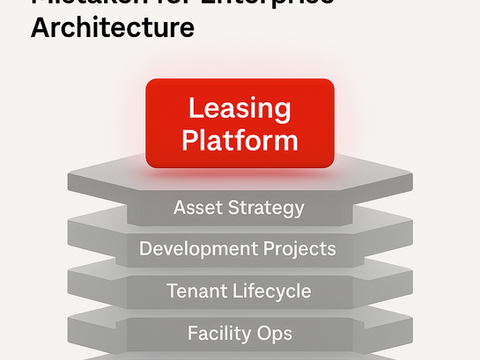top of page

Enterprise Intelligence
Transforming Strategy into Execution with Precision and Real Intelligence

Real Estate
Singular, Unified Anatomy for Operational Excellence


Real Estate EA FAQs - Why do 90 IT projects ≠ Real Estate Enterprise Architecture?
Most real estate organisations still treat Enterprise Architecture as an IT exercise, which is why EA efforts don’t change project delivery timelines, cost overruns, approval delays, sales velocity, leasing outcomes, asset performance, or cash-flow predictability. Real Estate EA ≠ Real Estate IT. This Director EA FAQ explains where traditional EA breaks down and how a true enterprise anatomy reveals the structure that IT alone cannot see, align, or repair. It explains the log


Case USA107: Why a Real Estate Platform Equated CRM Workflows with Enterprise Architecture
Agents could track leads, automate follow-ups, and generate listings faster — yet the enterprise structure linking property lifecycle management, transaction processing, compliance, marketing, and partner services was never modeled.


Case USA103: Why a Smart Building Program Equated IoT Sensor Networks with Enterprise Architecture Coherence
eal-time data dashboards improved visibility, automated controls cut costs, and sustainability scores improved — yet the enterprise structure linking building systems, tenant services, asset management, safety compliance, and financial planning was never modeled.


Case USA106: How a Co-Working Network Substituted Space Booking Platforms for Enterprise Architecture Structure
Members could reserve desks or meeting rooms via an app, usage analytics improved, and cross-location access expanded — yet the enterprise structure linking pricing strategy, occupancy optimization, member lifecycle, partner services, and financial performance was never modeled.


Case USA93: How a State Construction Permit System Confused Document Upload Tools with Enterprise Architecture
Builders could submit plans digitally, inspectors could review files remotely, and approval notifications were automated — yet the enterprise structure linking zoning rules, code compliance, inspection scheduling, enforcement actions, and fee management was never modeled.


Case USA14: Why a Smart City Program Camouflaged Vendor Integration as Enterprise Architecture
Devices connected, dashboards glowed, pilots impressed — yet citizen services, authority handoffs, and emergency logic lacked a modeled enterprise structure.


Case USA94: How a Co-Working Network Substituted Access Apps for Enterprise Architecture Maturity
Members could book meeting rooms, unlock doors with mobile passes, and manage accounts through an app — yet the enterprise structure linking pricing models, occupancy management, member lifecycle, partner services, and financial reporting was never modeled.


Case USA95: How a Real Estate MLS Claimed Data Feeds as Enterprise Architecture
Brokerages could pull more listings into their tools, property data was updated faster, and downstream portals expanded inventory — yet the enterprise structure linking listing lifecycle, compliance, syndication, transaction management, and partner systems was never modeled.


Case 14: Real Estate Conglomerate – A Leasing Platform Upgrade Mistaken for Enterprise Architecture 💲
This was a tech rollout across departments — not an enterprise-wide design.


Case M20: Real Estate Authorities – A Project Approval Portal Isn’t an Enterprise Architecture 💲
Projects were approved. Transactions were tracked. But the real estate enterprise was never architected.


Mastering Real Estate Complexity: A CIO's Path to Excellence with the ICMG Anatomy Model
Many CIOs struggle with restoring trust in technology where previous initiatives have fallen short of delivering measurable value.


Why Traditional Enterprise Architecture Fails Real Estate (And What Actually Works)
Traditional EA models have long fallen short in addressing the complex, interconnected realities of the real estate industry.


The Hidden Risks of Capability Models in Real Estate M&A: Why “One Enterprise, One Anatomy” Ensures True Integration
Traditional Capability Models: Why They Fall Short in M&A


Elevating Real Estate Enterprise Architecture with the Enterprise Anatomy Model
For real estate leaders, this shift represents not just a technical upgrade, but a strategic evolution


One Enterprise, One Anatomy – A CEO’s Perspective on Real Estate Success 💲
The way building architecture ensures the longevity and functionality, the architecture of a real estate enterprise will guarantee longevity


Why Real Estate Needs the ICMG Anatomy Model Over Capability Models
Capability Models frequently offer only a partial view, assuming this fragment is representative of the full system.


Four Real Estate Product Segments: Challenges and ICMG Enterprise Anatomy Solutions
Managing these challenges requires more than just quick fixes or brainstorming sessions.


How Stage 2-7 Problem Analysis and 1-13 Strategy Execution Solved Coworking Space Challenges
Despite launching discounted membership plans and conducting marketing campaigns, the coworking space struggled to attract new clients.


Breaking Down Complexity using Deconstruction Technique to A Real Estate Booking Platforms
ICMG Model allows real estate enterprises to move from surface-level descriptions to a detailed, actionable blueprint


How Stage 2-7 Problem Analysis and 1-13 Strategy Execution Solved Housing Real Estate Challenges
Brainstorming sessions among the teams generated temporary ideas, such as offering rental discounts and incentives


How Stage 2-7 Problem Analysis and 1-13 Strategy Execution Solved Commercial Real Estate Challenges
Brainstorming sessions among the Leasing, Operations, and Finance departments led to short-term fixes, such as adjusting rent levels and off


How Stage 2-7 Problem Analysis and 1-13 Strategy Execution Solved Retail Real Estate Challenges
What happens when actions did not address the deeper, structural issues, and the mall continued to struggle.


Analysis of 15 Real Estate Department Using the ICMG Enterprise Anatomy Model
Examining each department through the lens of six critical perspectives—Strategy, Processes, Systems, Technology components, Implementation,
bottom of page
